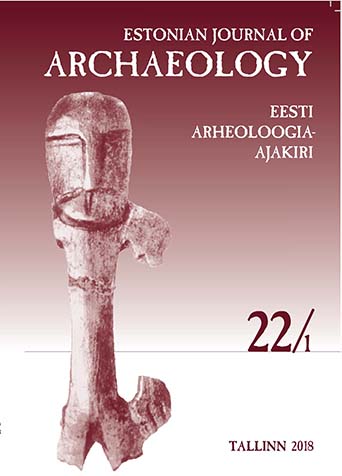ENVIRONMENTAL STUDIES AT THE KOHTLA-VANAKÜLA IRON AGE SACRIFICIAL SITE, NORTH-EAST ESTONIA
ENVIRONMENTAL STUDIES AT THE KOHTLA-VANAKÜLA IRON AGE SACRIFICIAL SITE, NORTH-EAST ESTONIA
Author(s): Aivar Kriiska, Ester Oras, Triine Nirgi, Merrit Shanskiy, Atko Heinsalu, Santeri Vanhanen, Tomi P. LuotoSubject(s): Archaeology
Published by: Teaduste Akadeemia Kirjastus
Summary/Abstract: Kohtla-Vanaküla (Kohtla from here onwards) sacrificial site is an Iron Age weapons and tools deposit from the beginning of the Christian Era to around 800 AD (based on artefact chronology and AMS dates from the wooden handle remnants of the items’ sockets and the charcoal pieces collected from the layer containing the finds). It is a significant discovery among its kind in Estonia and on a wider scale not only due to the number of items, but also because for the first time in Estonia it was possible to study the assemblage at least partially in its original state. Parallel to the archaeological excavations, different multidisciplinary studies were performed to determine the area’s natural environment during the period when the items were deposited. The fieldwork was conducted in summer 2014. This article presents the results of geological, soil, micromorphological, archaeobotanical, and diatom studies.Based on the retrieved data, it is not possible to completely reconstruct the natural environment of the sacrificial site for the period of use, but some pointers have been established. Presumably, the site was, at least during high water, a flooded meadow where water might have dwelt longer in ground concavities. One of the main factors favouring the wet conditions is impermeable thick argillaceous till that most likely prevented water from seeping into the ground. Moreover, the sacrificial site is located in a slightly concave topography and this also prevented the draining of the water even further in this specific spot. One can assume that the items were placed in a small marshy depression that was, at least part of the year, filled with water. The items were situated in a layer that indicates the formation of peat; this anoxic soil was the reason why the iron items were preserved.
Journal: Eesti Arheoloogia Ajakiri
- Issue Year: 22/2018
- Issue No: 1
- Page Range: 66-79
- Page Count: 14
- Language: English

